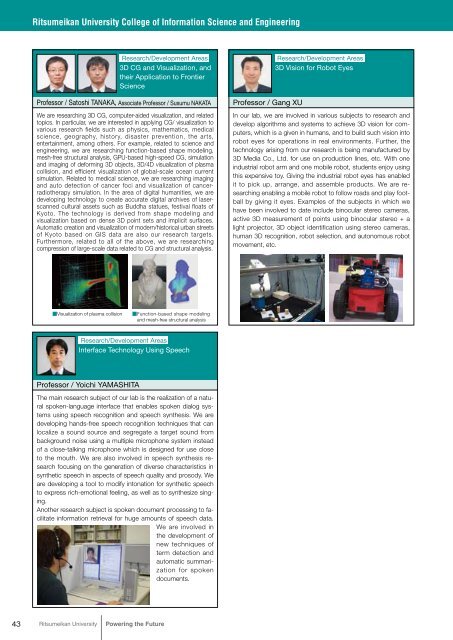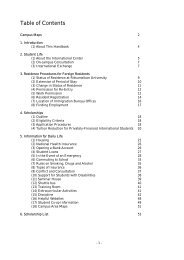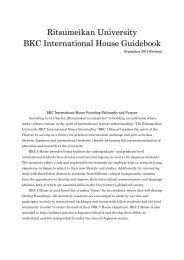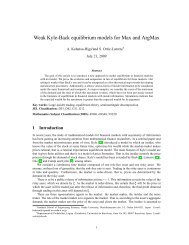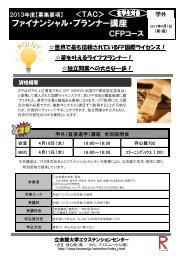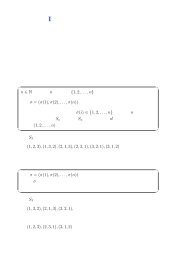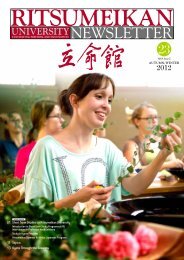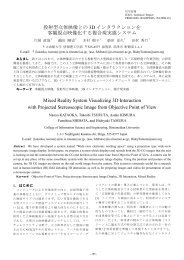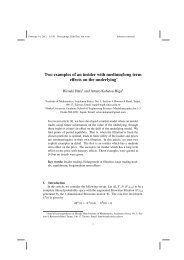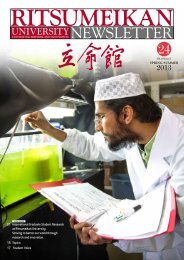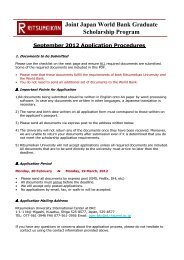Powering the Future - 立命館大学
Powering the Future - 立命館大学
Powering the Future - 立命館大学
You also want an ePaper? Increase the reach of your titles
YUMPU automatically turns print PDFs into web optimized ePapers that Google loves.
Ritsumeikan University College of Information Science and Engineering<br />
Research/Development Areas<br />
3D CG and Visualization, and<br />
<strong>the</strong>ir Application to Frontier<br />
Science<br />
Professor / Satoshi TANAKA, Associate Professor / Susumu NAKATA<br />
We are researching 3D CG, computer-aided visualization, and related<br />
topics. In particular, we are interested in applying CG/ visualization to<br />
various research fields such as physics, ma<strong>the</strong>matics, medical<br />
science, geography, history, disaster prevention, <strong>the</strong> arts,<br />
entertainment, among o<strong>the</strong>rs. For example, related to science and<br />
engineering, we are researching function-based shape modeling,<br />
mesh-free structural analysis, GPU-based high-speed CG, simulation<br />
and imaging of deforming 3D objects, 3D/4D visualization of plasma<br />
collision, and efficient visualization of global-scale ocean current<br />
simulation. Related to medical science, we are researching imaging<br />
and auto detection of cancer foci and visualization of cancerradio<strong>the</strong>rapy<br />
simulation. In <strong>the</strong> area of digital humanities, we are<br />
developing technology to create accurate digital archives of laserscanned<br />
cultural assets such as Buddha statues, festival floats of<br />
Kyoto. The technology is derived from shape modeling and<br />
visualization based on dense 3D point sets and implicit surfaces.<br />
Automatic creation and visualization of modern/historical urban streets<br />
of Kyoto based on GIS data are also our research targets.<br />
Fur<strong>the</strong>rmore, related to all of <strong>the</strong> above, we are researching<br />
compression of large-scale data related to CG and structural analysis.<br />
Professor / Gang XU<br />
Research/Development Areas<br />
3D Vision for Robot Eyes<br />
In our lab, we are involved in various subjects to research and<br />
develop algorithms and systems to achieve 3D vision for computers,<br />
which is a given in humans, and to build such vision into<br />
robot eyes for operations in real environments. Fur<strong>the</strong>r, <strong>the</strong><br />
technology arising from our research is being manufactured by<br />
3D Media Co., Ltd. for use on production lines, etc. With one<br />
industrial robot arm and one mobile robot, students enjoy using<br />
this expensive toy. Giving <strong>the</strong> industrial robot eyes has enabled<br />
it to pick up, arrange, and assemble products. We are researching<br />
enabling a mobile robot to follow roads and play football<br />
by giving it eyes. Examples of <strong>the</strong> subjects in which we<br />
have been involved to date include binocular stereo cameras,<br />
active 3D measurement of points using binocular stereo + a<br />
light projector, 3D object identification using stereo cameras,<br />
human 3D recognition, robot selection, and autonomous robot<br />
movement, etc.<br />
■Visualization of plasma collision<br />
■Function-based shape modeling<br />
and mesh-free structural analysis<br />
Research/Development Areas<br />
Interface Technology Using Speech<br />
Professor / Yoichi YAMASHITA<br />
The main research subject of our lab is <strong>the</strong> realization of a natural<br />
spoken-language interface that enables spoken dialog systems<br />
using speech recognition and speech syn<strong>the</strong>sis. We are<br />
developing hands-free speech recognition techniques that can<br />
localize a sound source and segregate a target sound from<br />
background noise using a multiple microphone system instead<br />
of a close-talking microphone which is designed for use close<br />
to <strong>the</strong> mouth. We are also involved in speech syn<strong>the</strong>sis research<br />
focusing on <strong>the</strong> generation of diverse characteristics in<br />
syn<strong>the</strong>tic speech in aspects of speech quality and prosody. We<br />
are developing a tool to modify intonation for syn<strong>the</strong>tic speech<br />
to express rich-emotional feeling, as well as to syn<strong>the</strong>size singing.<br />
Ano<strong>the</strong>r research subject is spoken document processing to facilitate<br />
information retrieval for huge amounts of speech data.<br />
We are involved in<br />
<strong>the</strong> development of<br />
new techniques of<br />
term detection and<br />
automatic summarization<br />
for spoken<br />
documents.<br />
43 Ritsumeikan University <strong>Powering</strong> <strong>the</strong> <strong>Future</strong>


